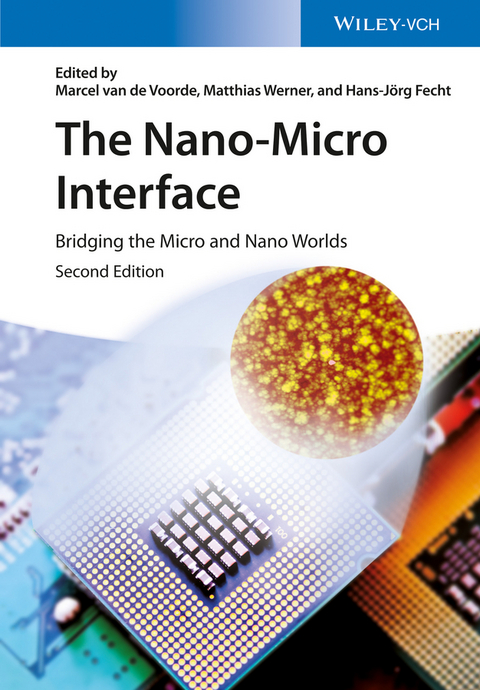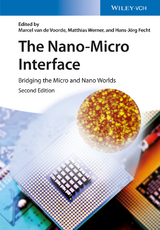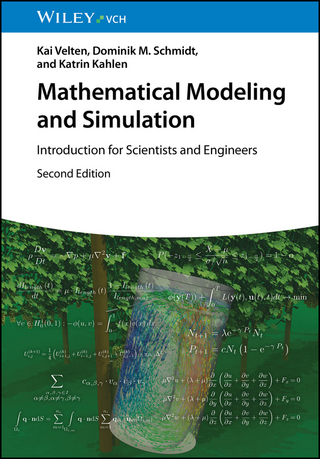The Nano-Micro Interface
Wiley-VCH (Verlag)
978-3-527-33633-3 (ISBN)
- Titel ist leider vergriffen;
keine Neuauflage - Artikel merken
.
Controlling the properties of materials by modifying their composition and by manipulating the arrangement of atoms and molecules is a dream that can be achieved by nanotechnology. As one of the fastest developing and innovative -- as well as well-funded -- fields in science, nanotechnology has already significantly changed the research landscape in chemistry, materials science, and physics, with numerous applications in consumer products, such as sunscreens and water-repellent clothes. It is also thanks to this multidisciplinary field that flat panel displays, highly efficient solar cells, and new biological imaging techniques have become reality.
This second, enlarged edition has been fully updated to address the rapid progress made within this field in recent years. Internationally recognized experts provide comprehensive, first-hand information, resulting in an overview of the entire nano-micro world. In so doing, they cover aspects of funding and commercialization, the manufacture and future applications of nanomaterials, the fundamentals of nanostructures leading to macroscale objects as well as the ongoing miniaturization toward the nanoscale domain. Along the way, the authors explain the effects occurring at the nanoscale and the nanotechnological characterization techniques. An additional topic on the role of nanotechnology in energy and mobility covers the challenge of developing materials and devices, such as electrodes and membrane materials for fuel cells and catalysts for sustainable transportation. Also new to this edition are the latest figures for funding, investments, and commercialization prospects, as well as recent research programs and organizations.
Hans-Jörg Fecht is Chaired Professor in the Department of Materials Science and Engineering and Director of the Center of Excellence "Nano- and Micromaterials" at the University of Ulm and Senior Scientist for "Nanostructured Materials" at the Institute for Nanotechnology of the Karlsruhe Institute of Technology. He studied material science at the University of Saarbrücken where he received his Ph.D. in 1984. He became full professor at the University of Augsburg after a postdoctoral fellowship at the University of Wisconsin-Madison and the California Institute of Technology, USA. In 1993 he was appointed Professor at the Technical University Berlin. Hans-Jörg Fecht was awarded with the Leibniz Prize of the German Research Foundation (DFG), named "Pioneer of Nanotechnology" (Deutsche Bank) and received the Innovation Award of the Association of German Engineers (VDI). Matthias Werner is Managing Director of the company Nano & Micro Technology Consulting (NMTC) in Berlin, Germany. He received his Ph.D. in electronic engineering from the Technical University of Berlin in 1994. He worked as a consultant and leader of a microtechnology expert team of Deutsche Bank AG for several years with major responsibility in establishing a micro and nano technology infrastructure. He acted as manager federal research programs and as consultant for the VDI/VDE-IT where he evaluated the funding of research and industry projects. He is chairman of various international conferences, member of the National Strategy Group for the UK Micro/Nano Manufacturing Initiative and the Institute of Nanotechnology, and coeditor of the International Magazine on Smart Systems Technology (mstnews). Marcel Van de Voorde is special advisor at IMEC, Belgium. Currently, his knowledge and 40 years' experience in university education, research and management was honored with the gold medal of the Fondation du Mérite Européen. He studied industrial and chemical engineering and received his Ph.D. in nuclear engineering from the Nancy-Université, France. He was co-founder and professor at the Hoger Instituut der Kempen, Geel, and the Technical Institute Don Bosco, Hoboken in Belgium. He further holds professorships at the Catholic University of Leuven, the Ghent University, the Delft University of Technology and is visiting professor at several recognized universities in Europe, US, Japan and China. He was active as advisor to various institutions such as the CERN, the European Commission and the Max Planck Institute for Solid State Research.
Introduction
NANOTECHNOLOGY RESEARCH FUNDING AND COMMERCIALIZATION PROSPECTS
A European Strategy for Micro- and Nanoelectronic Components and Systems
Governmental Strategy for the Support of Nanotechnology in Germany
Overview on Nanotechnology R&D and Commercialization in the Asia Pacific Region
Near Industrialization of Nanotechnologies Developed in JST's Nanomanufacturing Research Area in Japan
Quo Vadis Nanotechnology?
DEVELOPMENT OF MICRO AND NANOTECHNOLOGIES
Micro/Nanoroughness Structures on Superhydrophobic Polymer Surfaces
Multisensor Metrology Bridging the Gap to the Nanometre - New Measurement Requirements and Solutions in Wafer-Based Production
Nanostructural Metallic Materials - Nanoengineering and Nanomanufacturing
Bulk Metallic Glass on Micro to Nano Length Scale Applications
From Oxide Nanoparticles to Nanoceramics: Processes and Applications
NANOELECTRONICS AND SYSTEM INTEGRATION
Creating Tomorrow's Applications through Deeper Collaboration between Technology and Design
Multiwalled Carbon Nanotube Network-Based Sensors and Electronic Devices
Thin Film Piezomaterials for Bulk Acoustic Wave Technology
Properties and Applications of Ferroelectrets
BIOMEDICAL TECHNOLOGIES AND NANOMEDICINE
Translation Medicine: Nanoscience and Nanotechnology to Improve Patient Care
Nanotechnology Advances in Diagnostics, Drug Delivery, and Regenerative Medicine
Biofunctional Surfaces
Biomimetic Hierarchies in Diamond-Based Architectures
ENERGY AND MOBILITY
Nanotechnology in Energy Technology
The Impact of Nanoscience in Heterogeneous Catalysis
Processing of Nanoporous and Dense Thin Film Ceramic Membranes
Nanotechnology and Nanoelectronics for Automotive Applications
PROCESS CONTROLS AND ANALYTICAL TECHNIQUES
Characterisation of Nanostructured Materials
Surface Chemical Analysis of Nanoparticles for Industrial Applications
Nanometre-Scale View of the Electrified Interface: A Scanning Probe Microscopy Study
CREATIVE STRATEGIES CONNECTING NANOMATERIALS TO THE MACROSCALE WORLD
Nanostructured Cement/Concrete
Hydrogen and Electromobility Agenda
Size Effects in Nanomaterials and Their Use in Creating Architectured Structural Materials
Position and Vision of Small- and Medium-Sized Enterprises Boosting Commercialization
Optical Elements for EUV Lithography and X-ray Optics
Industrial Production of Nanomaterials with Grinding Technologies
Guidelines for Safe Operation with Nanomaterials
VISIONS FOR THE FUTURE
Industrialization - Large-Scale Production of Nanomaterials/Components
| Erscheint lt. Verlag | 28.1.2015 |
|---|---|
| Sprache | englisch |
| Maße | 170 x 244 mm |
| Gewicht | 1945 g |
| Themenwelt | Naturwissenschaften ► Chemie |
| Technik ► Maschinenbau | |
| Schlagworte | Chemie • Chemistry • Dünne Schichten, Oberflächen u. Grenzflächen • Electrical & Electronics Engineering • Electrical & Electronics Engineering • Elektronischer Werkstoff • Elektrotechnik u. Elektronik • Materials Science • Materialwissenschaften • MEMS • Mikroelektronik • Nanotechnologie • Physical Chemistry • Physikalische Chemie • Sensor • Thin Films, Surfaces & Interfaces • Thin Films, Surfaces & Interfaces |
| ISBN-10 | 3-527-33633-8 / 3527336338 |
| ISBN-13 | 978-3-527-33633-3 / 9783527336333 |
| Zustand | Neuware |
| Informationen gemäß Produktsicherheitsverordnung (GPSR) | |
| Haben Sie eine Frage zum Produkt? |
aus dem Bereich




